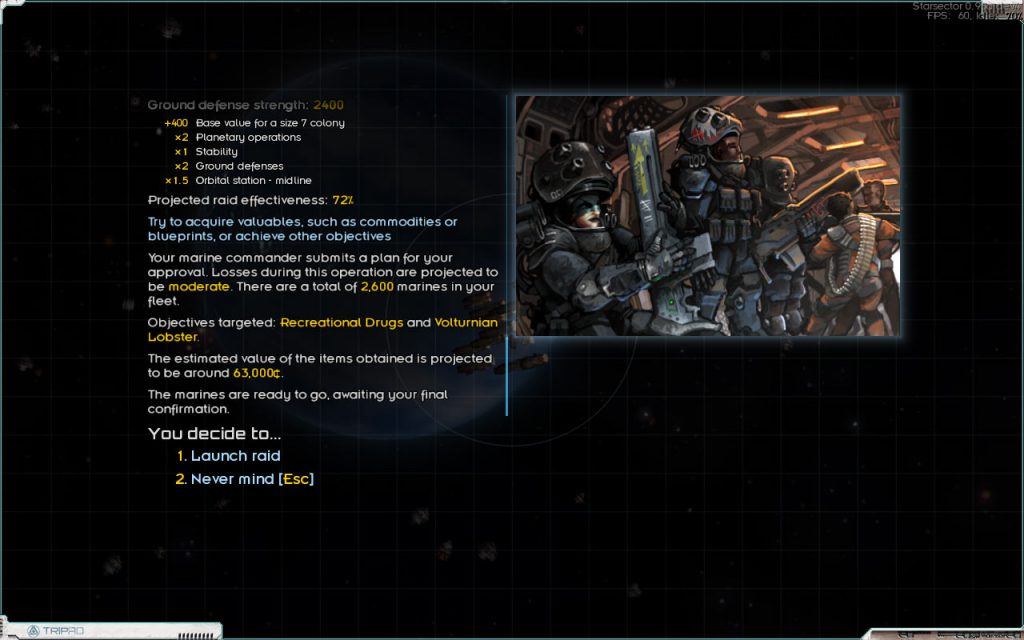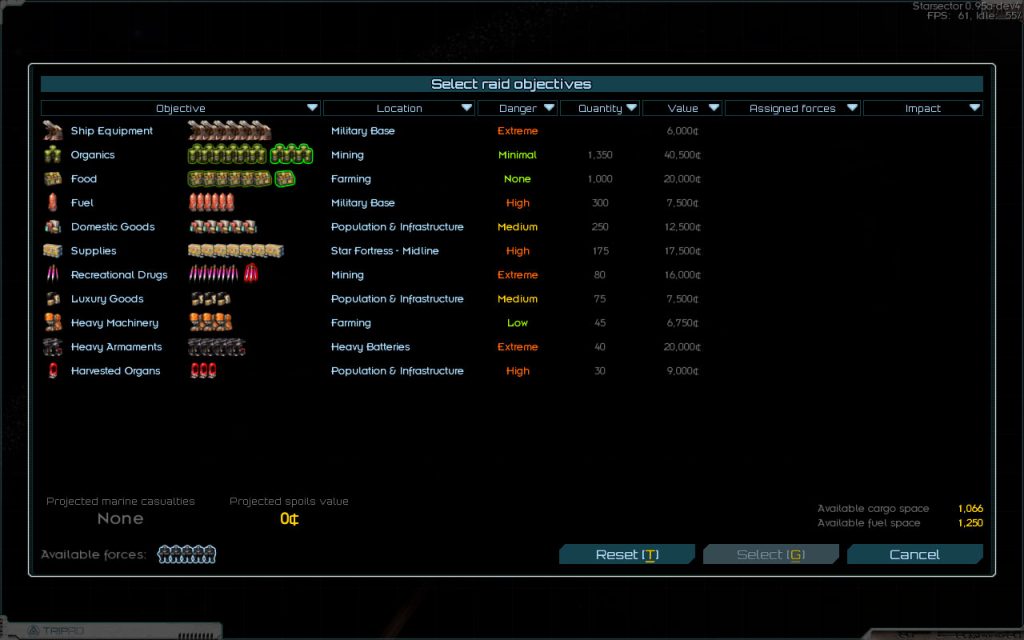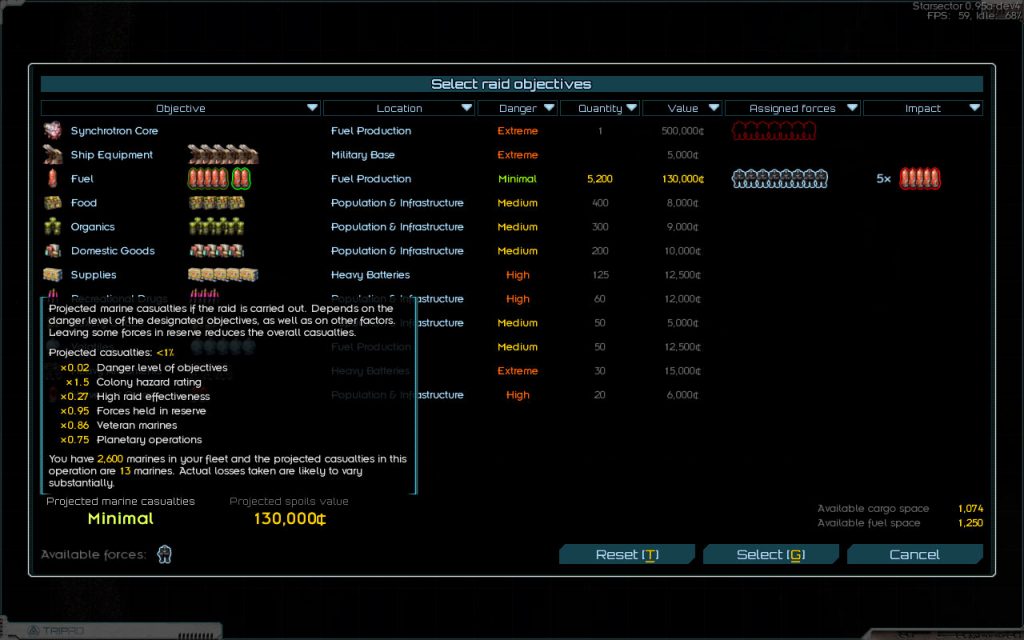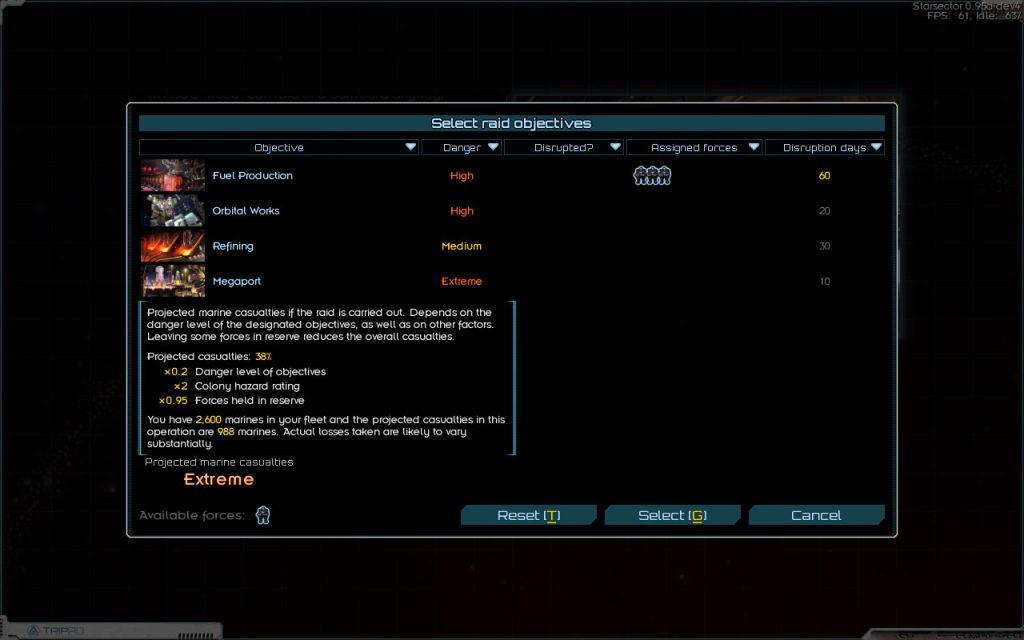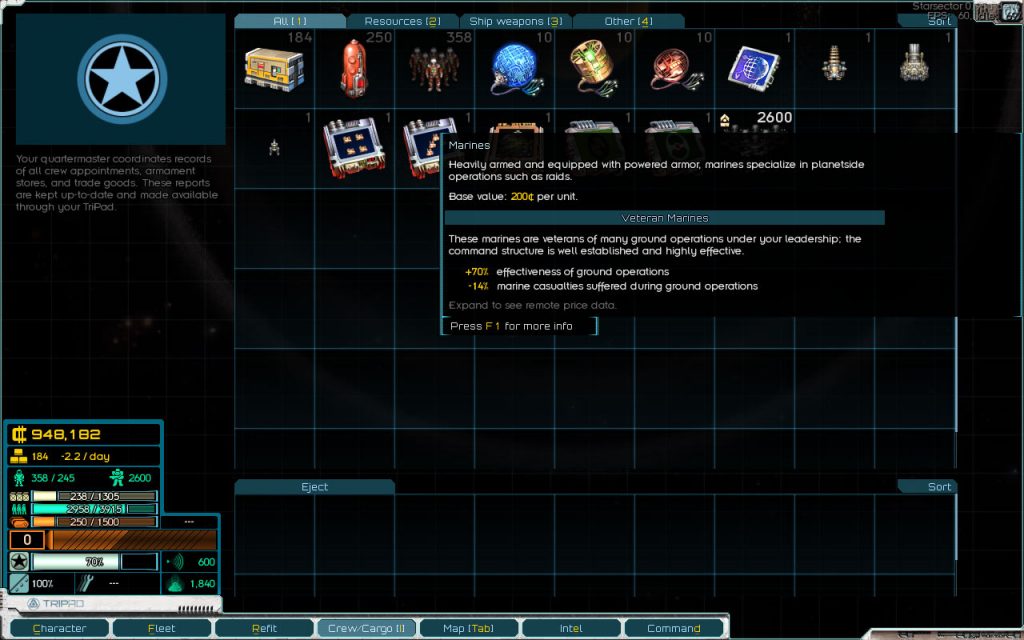Raiding for Fun and Profit
I’d started out trying to add a story point option that would, to quote my TODO list, “make ground raids more of an early-game activity the player can engage in”. Some time later, I ended up with a total revamp of the ground-raid system, and no story point option. I promise, I can explain!
(If you’re unfamiliar with story points, see this blog post. In brief, they’re limited “do cool things” points that you’ll gain as you level up. Both the points and the cool things to spend them on will be in the next release.)
Now then, back to how this happened. Story points are not an end unto themselves – the goal of the TODO item was, after all, entirely about ground raids in the early game; story points were just a possible way to do it. So, the first thing I’d tried was letting the player use a story point to stage a “surprise” raid, with higher effectiveness. This means you don’t need as many marines to accomplish something useful, which in turn means you can do it earlier in the game. Technically correct (the best kind!), but also, doesn’t hold up.
The problem is that, as it stands, raids fill a very specific mechanical niche. Couldn’t find a Pristine Nanoforge or a specific blueprint while exploring the Sector? Raid one of the core worlds that has them (sometimes into the ground, because there’s a random element), and you can eventually get them. It’s a safety net for being able to obtain most things in any given playthrough, and this aspect of it is fundamentally more appropriate to the late game.
The other part of raiding is you get a bunch of the commodities the colony either produces or just has a lot of. The amount you get is based on your raid effectiveness, so if you had boosted effectiveness from a “surprise” raid early in the game, chances are you’d just get more bulk items than you had room to take.
So, just boosting the effectiveness of raiding using a story point won’t make raids better in the early game. What would?
The main thing that stood out to me is giving the player more control about what they get from a raid. “A bunch of random stuff from the colony” is just not compelling in the early game, where what you need at the moment is often very specific. (If we’re being honest, it’s a tough sell in the late game, too; the main thing raiding really does is be the aforementioned safety net.)
New Design
More control means giving the player choices. The main pitfall would be making raiding into a minigame; we want to avoid that – in a minigame, either there’s a “right” set of choices and so it doesn’t matter, or it’s a chore, or it’s an entirely separate game that’s far too involved for the role it plays.
Therefore, all the choices should be about considerations external to the raid itself, not about making the raid’s performance better or worse. Whether the raid is successful or not should be based on its context – that is, whether you got what you needed out of the raid, and if the cost was too high or not.
So: there are multiple raid objectives you can select, and you have a number of marine “units” to assign to the various objectives, based on your raid effectiveness – the strength of your fleet’s marine forces, compared to the strength of the defenders.
Commodities are the most common objective – food, supplies, fuel, that sort of thing. In addition to regular commodities, it’s also possible to raid for ship equipment – ship weapons, fighter production chips, and hullmod specifications.
To make raiding an even more appealing option earlier in the game, it also grants significant amounts of experience.
Danger Level & Marine Casualties
Each objective has a “danger level” which affects the losses your marines will take. For commodities, the danger depends on the commodity itself, the best source of it at the colony, and its economic conditions.
For example, lets consider supplies – a staple commodity with a moderate inherent risk. Grabbing them from a Military Base is going to be more dangerous than grabbing them from a Spaceport. If there’s a shortage, it’ll be even more dangerous.
On the other hand, raiding Heavy Industry (which produces supplies) to get them will be less risky. If there’s a surplus, it’ll be safer still – and the supplies will be much more plentiful.
Other factors that affect marine casualties are:
- The colony’s hazard rating (increase)
- Repeated raids of the same colony in a short time (increase)
- High raid effectiveness (decrease)
- Marine units held in reserve – that is, not assigned to any objective (decrease)
- The “Planetary Operations” skill (decrease)
Special Items and Blueprints
In addition to commodities and ship equipment, you can also raid for special items (such as the aforementioned Nanoforges) and blueprints.
So, let’s say there’s a Pristine Nanoforge you’ve got your eye on, and you want to get it. How does this work? You’re able to assign multiple marine units to an objective to get more stuff, but there’s only one Nanoforge, so that doesn’t really make sense.
My first thought here was to just give a 10% or so chance of success for each marine unit assigned. Makes sense in theory, but it also means that you could get this extremely high value item very early on in the game with only a moderately lucky roll. It also means that you might repeatedly fail to get it in the late game with a few moderately unlucky rolls. This is… workable, probably, but I wasn’t happy with it.
Instead, these kinds objectives have a required number of marine units that have to be assigned – if you don’t have that many – that is, if your raid effectiveness is too low – you can’t achieve them. If you do have enough, you’re guaranteed success.
Blueprints work in a similar fashion – there’s still some RNG in which blueprints you get, but you *will* get some, and blueprints you don’t already know are preferred, so even if there’s still some randomness here, there’s a clear path to getting what you want that guarantees you’ll eventually get there.
Disruption Raids
It’s also possible to raid not to get items of value, but to simply disrupt the operations of an industry. This has been adjusted to use similar mechanics – different industries have different danger levels, which affect casualties and the duration of the disruption. As with other objectives, it’s possible to split your forces to disrupt multiple industries at once.
Fleet Reactions
One of the design tenets is that things you do in the campaign should, generally, lead towards combat in some way. For raids, this takes the form of that faction’s in-system fleets responding to it – some patrols will make a beeline for the colony, and will be aware that your fleet is hostile despite its transponder status. The same addition now also applies for bombardments.
Marines
One of the things I wanted to achieve with this is to make marines feel less like a commodity and to encourage the player to care about them – at least a bit! – and to minimize casualties.
My initial thought was to keep track of losses taken in raids, and, if those are high, to have future marines demand additional “hazard pay” – i.e. just making them more expensive. I might still do that, but I wanted to see if I could do something positive here – a reward mechanic instead of a punishment one.
Both have their place, of course (and “punishment”-type mechanics can I think make things easier to balance because they impede out-of-control growth by the player), but if the goal is to care about the marines, it feels like a reward mechanic would work better.
So! Marines now gain experience from raids, and this translates directly into a generous increase in raid effectiveness, and a more modest reduction in casualties taken. Hiring new marines dilutes the experience and reduces the bonuses (no experience is lost, it’s just redistributed). It’s also possible to drop off experienced marines in storage, or in cryopods, and have them retain their experience level.
There are 4 experience ranks: regular, experienced, veteran, and elite. To avoid the player needing to game boundary conditions (i.e. “if I buy just one less marine, they’ll stay “veteran”, etc), the bonuses are based on the experience level instead of being based on rank – i.e. the raid effectiveness bonus goes smoothly from +0% to +100%. The rank itself is just an indicator of where on that continuum the current experience level lies.
Critically, there’s still just one type of “marines”; the experience level is shared in common among all the marines in your fleet, rather than there being separate stacks of elite marines, veteran marines, and so on. This makes it a lot easier to manage (for example, when computing and showing marine casualties) and reduces clutter.
Some more changes that go hand in hand with this, to make marines feel a bit less like a commodity and a bit more special:
- Marines are harder to find – less of them, more expensive (probably, still testing this), etc
- The bar event that gives you marines now gives you more marines, and they’re elite
- It’s possible to find marines in cryopods during salvage ops
Crew
This isn’t really on topic for this blog post, but it’s a bit of an elephant in the room if you’ve been following the game – does this mean that crew experience levels are making a comeback?
I’ve thought about it, and I don’t think it’d be a good idea for a couple of reasons. First off, the obvious effect that crew experience might have – increasing maximum combat readiness – doesn’t actually work out well. If it did that, you’d end up spending a ton of supplies every time the crew CR bonus increases (since all of your ships would be below maximum CR at that point). The alternative is a slew of miscellaneous bonuses that are basically like CR, but it’s … messy. Nothing really satisfying comes to mind here.
Secondly – and more importantly – raids are designed from the ground up around managing marine casualties, or at the very least being very aware of them. It’s one of the primary factors in deciding which objectives to designate. Fleet battles, on the other hand… offhand, I’m not even sure what the expected crew losses might be in a big fight. It would also vary a lot depending on the kinds of ships you’re using – carriers would suffer, as would low-tech ships that rely on armor and hull over shields, and thus take more crew losses. There are all sorts of implications both mechanically and for the UI.
That said, it might still be worthwhile, and I’ll keep an eye on it. It’s just very much not something I want to add “just because”.
Overview
Overall, the system gives the player fine-grained control over what they want to accomplish, and ways to manage marine casualties. It also adds more opportunities to take advantage of surpluses and shortages, as well as procurement missions. In conjunction, trade has been slightly adjusted to make selling larger quantities of bulk commodities more profitable. Raiding for commodities also causes temporary deficits, creating yet more potential opportunities.
The colonies themselves become more meaningfully distinct – the difference between raiding for, say, Organics from a producer with an excess vs from a consumer (let alone one with a shortage) is immense, and knowing which colonies are the best sources of what items is critical for an effective raider.
Finally, raiding should now both be more useful in the early game, and a smoother experience in the late game, due to a major toning down of the RNG elements.
The new system also adds a lot of room both for scripted events in vanilla, and in mods. It’s possible to add entirely custom objectives – e.g. a “kidnap a VIP” type mission, or, well… just about anything!
Comment thread here.
Tags: blueprints, colony, commodities, experience, marines, raid, raiding, ship weapons
